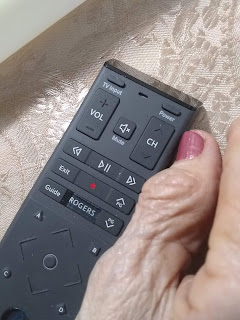Pushing that button: not for Seniors
TV is still ubiquitous. Most seniors spend hours in front of it. But many need help to even start it, and when it comes to navigation, formerly simple tasks such as adjusting volume or changing channels are a challenge, to say the least. Without assistance, they are stuck, and their feelings run the spectrum from helplessness to techno-rage. This is not good - a nervous breakdown or heart attack may not be far away. How can someone with thick or trembling fingers and poor sight manipulate a device such as this one? What were the designers thinking when they came up with this non-sense of a remote control? Add to that cognitive impairment (they don't understand or remember what needs to be done), and the ubiquitous TV, the only activity some old people can still find pleasure in, becomes out of reach. They are cut off, unless a charitable other person is nearby.
Where to start with the shortcomings of this particular remote control shown in the photo? This is on offer (and there is no alternative!) in an age when we talk about empowerment, universal design, accessibility, "60 is the new 40" and the like.
Shouldn't the Power button be made distinguishable from anything else, and large enough to accommodate the push of a normal finger, let alone one enlarged by old age and arthritis? Maybe it was designed for cats' claws, the way it is! Volume and Channel are also too small and confoundable. And the screen navigation buttons is an area that can barely be distinguished even by someone with good sight and touch. The keyboard buttons are way too small to be manipulated with ease, and all other buttons suffer from this too.
And that's what seniors get when they can afford the rates charged by the provider. The total absence of a senior-friendly package of channels, priced affordably is remarkable.
One could ask: What kind of people and professionals are those who designed and tested and approved this device...what happened to Universal design, Accessibility, Design Thinking, Empathy, protecting the disabled, and all this good stuff that inundates current best practices. And what happened to the good old days ways, when two human-size radio-style buttons (Volume; Channel) could do the whole job? Is there no one left to draw a necessary lesson for our complicated world of today?
Last updated: 2020 Aug 23
Photo credit: personal


Comments
Post a Comment